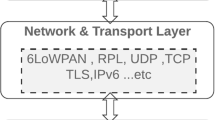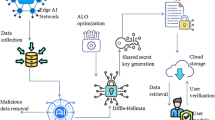Abstract
Nowadays, the research on security authentication for radio-frequency identification (RFID) systems has become a building block of Internet of Things (IoT). Accordingly, the question how to address the security challenge in RFID systems is a critical topic. Besides, the development of an appropriate RFID authentication protocol should be considered as an important encryption protocol to guarantee the security of the exchanges, since it could provide authentication between the tag and the server. Thus, many research based on ECC have been conducted in this area to address the security requirements of the RFID system. To overcome the limitations of the existing schemes and to achieve both security and efficiency together for the IoT, we introduce a novel and efficient RFID authentication protocol-based Elliptic Curve Cryptography (ECC) to maintain security between RFID cards, card readers, and servers. The proposed protocol ensures security requirements and achieves mutual authentication. A comparison with the most recent protocols is performed in terms of security strength and computational performance. Finally, the suggested protocol is analyzed with the AVISPA tool. Based on the simulation findings, our protocol has demonstrated a high level of security; thus, it will be appropriate for a majority of IoT implementations.






Similar content being viewed by others
Data availability
The data are available and you can contact authors if you need to be share it with you.
References
Mohy-eddine M, Guezzaz A, Benkirane S, Azrour M. IoT-enabled smart agriculture: security issues and applications. In: Artificial intelligence and smart environment: ICAISE’2022. Springer; 2023. p. 566–571.
Dargaoui S, et al. An overview of the security challenges in IoT environment. In: Mabrouki J, Mourade A, Irshad A, Chaudhry SA, editors., et al., Advanced technology for smart environment and energy, environmental science and engineering. Cham: Springer International Publishing; 2023. p. 151–60.
Hazman C, Benkirane S, Guezzaz A, Azrour M, Abdedaime M. Intrusion detection framework for IoT-based smart environments security. In: Artificial intelligence and smart environment: ICAISE’2022. Springer; 2023. p. 546–552.
Azrour M, Mabrouki J, Farhaoui Y, Guezzaz A. Security analysis of Nikooghadam et al.’s authentication protocol for cloud-IoT. In: Gherabi N, Kacprzyk J, editors. Intelligent systems in big data, semantic web and machine learning, advances in intelligent systems and computing, vol. 1344. Cham: Springer International Publishing; 2021. p. 261–9.
Bhandari R, Kirubanand VB. Enhanced encryption technique for secure IoT data transmission. Int J Electr Comput Eng. 2019;9(5):3732.
Mohy-eddine M, Guezzaz A, Benkirane S, Azrour M. An efficient network intrusion detection model for IoT security using K-NN classifier and feature selection. Multimed Tools Appl. 2023. https://doi.org/10.1007/s11042-023-14795-2.
Mohy-eddine M, Guezzaz A, Benkirane S, Azrour M. An effective intrusion detection approach based on ensemble learning for IIoT edge computing. J Comput Virol Hacking Tech. 2022. https://doi.org/10.1007/s11416-022-00456-9.
Hazman C, Guezzaz A, Benkirane S, Azrour M. lIDS-SIoEL: intrusion detection framework for IoT-based smart environments security using ensemble learning. Clust Comput. 2022. https://doi.org/10.1007/s10586-022-03810-0.
Guezzaz A, Benkirane S, Azrour M. A novel anomaly network intrusion detection system for internet of things security. In: Azrour M, Irshad A, Chaganti R, editors. IoT and smart devices for sustainable environment. Cham: Springer; 2022. p. 129–38.
Douiba M, Benkirane S, Guezzaz A, Azrour M. Anomaly detection model based on gradient boosting and decision tree for IoT environments security. J Reliab Intell Environ. 2022. https://doi.org/10.1007/s40860-022-00184-3.
Douiba M, Benkirane S, Guezzaz A, Azrour M. An improved anomaly detection model for IoT security using decision tree and gradient boosting. J Supercomput. 2022;79(3):3392–411.
Chaganti R, Azrour M, Vinayakumar R, Naga V, Dua A, Bhushan B. A particle swarm optimization and deep learning approach for intrusion detection system in internet of medical things. Sustainability. 2022;14:12828.
Mansoor K, Ghani A, Chaudhry SA, Shamshirband S, Ghayyur SAK, Mosavi A. Securing IoT-based RFID systems: a robust authentication protocol using symmetric cryptography. Sensors. 2019;19(21):4752.
Chander B, Gopalakrishnan K. A secured and lightweight RFID-tag based authentication protocol with privacy-preserving in telecare medicine information system. Comput Commun. 2022;191:425–37.
Bendaoud S, Amounas F, El Kinani EH. A new image encryption scheme based on enhanced elliptic curve cryptosystem using DNA computing. In: Proceedings of the 2nd international conference on networking, information systems & security, 2019. p. 1–5.
Bendaoud S, Amounas F, Kinani EHE. Efficient map** method for elliptic curve cryptosystems based on PWLCM. In: Advances in smart technologies applications and case studies: selected papers from the first international conference on smart information and communication technologies, SmartICT 2019, September 26–28, 2019. Saidia, Morocco: Springer; 2020. p. 129–136.
Merabet F, Cherif A, Belkadi M, Blazy O, Conchon E, Sauveron D. New efficient M2C and M2M mutual authentication protocols for IoT-based healthcare applications. Peer-Peer Netw Appl. 2020;13:439–74.
Kumar V, Kumar R, Jangirala S, Kumari S, Kumar S, Chen C-M. An enhanced RFID-based authentication protocol using PUF for vehicular cloud computing. Secur Commun Netw. 2022;2022:1–18.
Ali U, et al. RFID authentication scheme based on hyperelliptic curve signcryption. IEEE Access. 2021;9:49942–59.
Kumar S, Banka H, Kaushik B, Sharma S. A review and analysis of secure and lightweight ECC-based RFID authentication protocol for Internet of vehicles. Trans Emerg Telecommun Technol. 2021;32(11): e4354.
Azrour M, Mabrouki J, Chaganti R. New efficient and secured authentication protocol for remote healthcare systems in cloud-IoT. Secur Commun Netw. 2021;2021:1–12. https://doi.org/10.1155/2021/5546334.
Azrour M, Mabrouki J, Guezzaz A, Kanwal A. Internet of things security: challenges and key issues. Secur Commun Netw. 2021;2021:1–11. https://doi.org/10.1155/2021/5533843.
Azrour M, Mabrouki J, Guezzaz A, Farhaoui Y. New enhanced authentication protocol for internet of things. Big Data Min Anal. 2021;4(1):1–9. https://doi.org/10.26599/BDMA.2020.9020010.
Radan A, Samimi H, Moeni A. A new lightweight authentication protocol in IoT environment for RFID tags. Int J Eng Technol. 2018. https://doi.org/10.14419/ijet.v7i4.7.23028.
Alamr AA, Kausar F, Kim J, Seo C. A secure ECC-based RFID mutual authentication protocol for internet of things. J Supercomput. 2018;74:4281–94.
Naeem M, Chaudhry SA, Mahmood K, Karuppiah M, Kumari S. A scalable and secure RFID mutual authentication protocol using ECC for internet of things. Int J Commun Syst. 2019;33(13): e3906. https://doi.org/10.1002/dac.3906.
Khan MA, Quasim MT, Alghamdi NS, Khan MY. A secure framework for authentication and encryption using improved ECC for IoT-based medical sensor data. IEEE Access. 2020;8:52018–27.
Gabsi S, Kortli Y, Beroulle V, Kieffer Y, Alasiry A, Hamdi B. Novel ECC-based RFID mutual authentication protocol for emerging IoT applications. IEEE Access. 2021;9:130895–913.
Izza S, Benssalah M, Drouiche K. An enhanced scalable and secure RFID authentication protocol for WBAN within an IoT environment. J Inf Secur Appl. 2021;58: 102705. https://doi.org/10.1016/j.jisa.2020.102705.
Noori D, Shakeri H, Niazi Torshiz M. An elliptic curve cryptosystem-based secure RFID mutual authentication for Internet of things in healthcare environment. EURASIP J Wirel Commun Netw. 2022;2022(1):64.
Gao M, Lu Y. URAP: a new ultra-lightweight RFID authentication protocol in passive RFID system. J Supercomput. 2022;78(8):10893–905. https://doi.org/10.1007/s11227-021-04252-y.
Meher BK, Amin R, Das AK, Khan MK. KL-RAP: an efficient key-less RFID authentication protocol based on ECDLP for consumer warehouse management system. IEEE Trans Netw Sci Eng. 2022;9(5):3411–20. https://doi.org/10.1109/TNSE.2022.3179830.
Lee T-F, Lin K-W, Hsieh Y-P, Lee K-C. Lightweight cloud computing-based RFID authentication protocols using PUF for e-healthcare systems. IEEE Sens J. 2023;23(6):6338–49. https://doi.org/10.1109/JSEN.2023.3242132.
Maurya PK, Bagchi S. Quadratic residue-based unilateral authentication protocol for RFID system. Multimed Tools Appl. 2023;82(11):16533–54. https://doi.org/10.1007/s11042-022-14170-7.
Sravana Kumar D. Encryption of data using elliptic curve over finite fields. Int J Distrib Parallel Syst. 2012;3(1):301–8. https://doi.org/10.5121/ijdps.2012.3125.
Amounas F, Kinani EHE, Chillali A. An application of discrete algorithms in asymmetric cryptography. Int Math Forum. 2011;6(49):2409–18.
Dinarvand N, Barati H. An efficient and secure RFID authentication protocol using elliptic curve cryptography. Wirel Netw. 2019;25(1):415–28.
Armando A, et al. The AVISPA tool for the automated validation of internet security protocols and applications. In: Etessami K, Rajamani SK, editors., et al., Computer aided verification, lecture notes in computer science. Berlin, Heidelberg: Springer; 2005. p. 281–5.
Viganò L. Automated security protocol analysis with the AVISPA tool. Electron Notes Theor Comput Sci. 2006;155:61–86. https://doi.org/10.1016/j.entcs.2005.11.052.
Lone TA, et al. Securing communication by attribute-based authentication in HetNet used for medical applications. EURASIP J Wirel Commun Netw. 2020;2020:1–21.
Author information
Authors and Affiliations
Corresponding author
Ethics declarations
Conflict of Interest
On behalf of all authors, the corresponding author states that there is no conflict of interest.
Additional information
Publisher's Note
Springer Nature remains neutral with regard to jurisdictional claims in published maps and institutional affiliations.
This article is part of the topical collection “Research Trends in Communication and Network Technologies” guest edited by Anshul Verma, Pradeepika Verma, and Kiran Kumar Pattanaik.
Rights and permissions
Springer Nature or its licensor (e.g. a society or other partner) holds exclusive rights to this article under a publishing agreement with the author(s) or other rightsholder(s); author self-archiving of the accepted manuscript version of this article is solely governed by the terms of such publishing agreement and applicable law.
About this article
Cite this article
Timouhin, H., Amounas, F. & Azrour, M. New ECC-Based IoT Authentication Protocol for Securing RFID Systems. SN COMPUT. SCI. 4, 785 (2023). https://doi.org/10.1007/s42979-023-02220-2
Received:
Accepted:
Published:
DOI: https://doi.org/10.1007/s42979-023-02220-2




